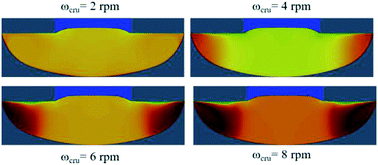Effect of crucible rotation on the temperature and oxygen distributions in Czochralski grown silicon for photovoltaic applications
Abstract
Temperature and oxygen distributions were numerically studied for the Czochralski (Cz) growth of 8′′ diameter silicon single crystals for photovoltaic applications. Fluctuations in the dopant concentration (striation pattern) in the grown crystal obtained by lateral photovoltage scanning (LPS) technique seems to be better correlated with simulated temperature fluctuations near the solid–liquid interface than with oxygen concentration oscillations. From the transient simulations of different crucible rotation rates, 2, 4, 6 and 8 rpm, it is indicated that the average oxygen melt concentration first decreases with increasing rotation rate and later increases. This suggests that a critical rotation rate exists where the oxygen concentration below the solid–liquid interface increases with increasing rotation rate. When comparing the temperature and oxygen distributions in the melt it was found that oxygen is more sensitive to changes in the rotation rate than the temperature.



 Please wait while we load your content...
Please wait while we load your content...